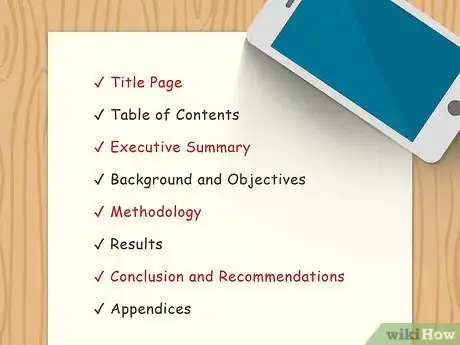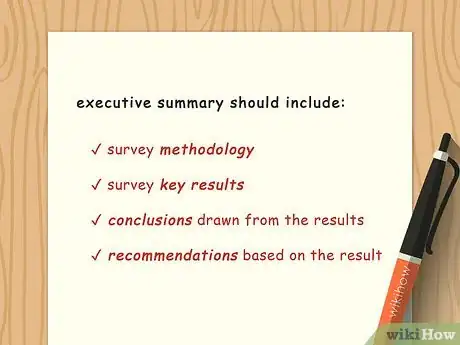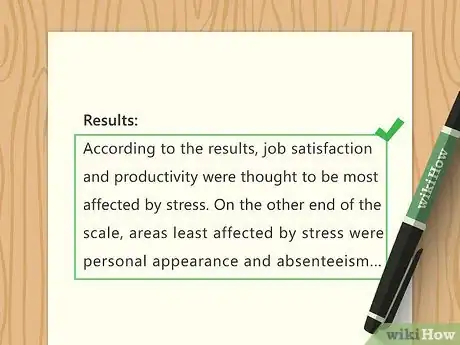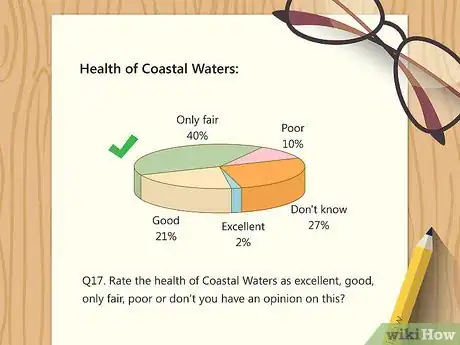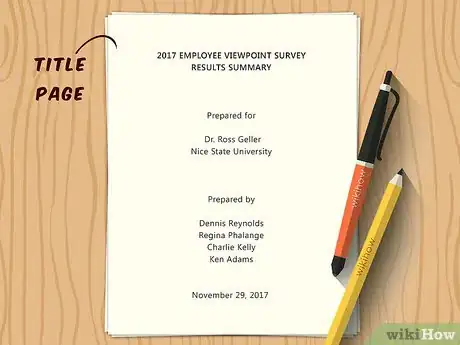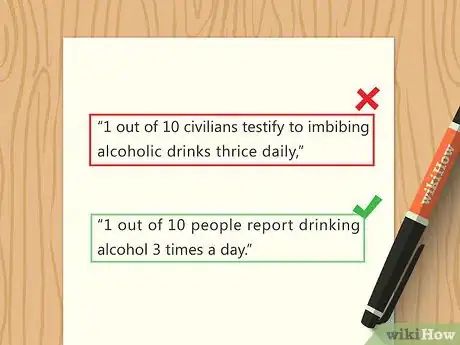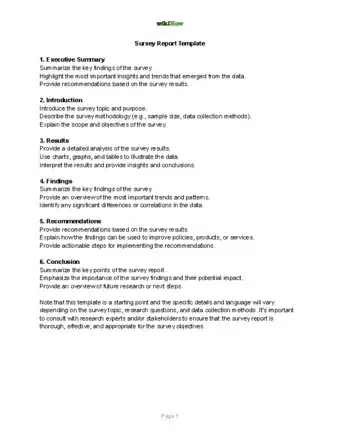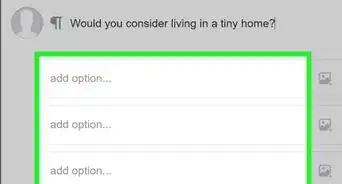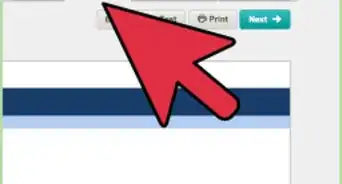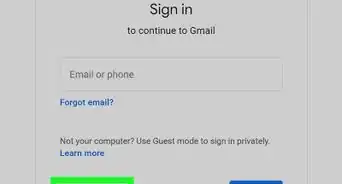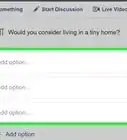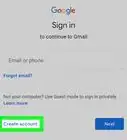This article was co-authored by wikiHow Staff. Our trained team of editors and researchers validate articles for accuracy and comprehensiveness. wikiHow's Content Management Team carefully monitors the work from our editorial staff to ensure that each article is backed by trusted research and meets our high quality standards.
wikiHow marks an article as reader-approved once it receives enough positive feedback. In this case, several readers have written to tell us that this article was helpful to them, earning it our reader-approved status.
This article has been viewed 339,855 times.
Learn more...
Once you have finished conducting a survey, all that is left to do is write the survey report. A survey report describes a survey, its results, and any patterns or trends found in the survey. Most survey reports follow a standard organization, broken up under certain headings. Each section has a specific purpose. Fill out each section correctly and proofread the paper to create a polished and professional report.
Steps
Writing the Summary and Background Info
-
1Break the report up into separate sections with headings. Survey reports usually use headings for each section. While there may be slight differences between reports, the headings are typically the same. The standard headings for a report are:[1]
- Title Page
- Table of Contents
- Executive Summary
- Background and Objectives
- Methodology
- Results
- Conclusion and Recommendations
- Appendices
-
2Write a 1-2 page executive summary paraphrasing the report. This comes at the very beginning of the report, after the table of contents. An executive summary condenses the main points of the report into a few pages. It should include:[2]
- Methodology of the survey.
- Key results of the survey.
- Conclusions drawn from the results of the survey.
- Recommendations based on the results of the survey.
Advertisement -
3State the objectives of the survey in the background section. Start the section by saying why the survey was conducted. Explain the hypothesis and goals of the survey. You usually don't need to write more than a page. Make sure to identify the:[3]
- Study or target population: Who is being studied? Do they belong to a certain age group, cultural group, religion, political belief, or other common practice?
- Variables of the study: What is the survey trying to study? Is the study looking for the association or relationship between two things?
- Purpose of the study: How will this information be used? What new information can this survey help us realize?
-
4Provide background information by explaining similar research and studies. This research can help you determine if your survey results support current beliefs on the topic or disagree with them. Write 2 or more pages explaining the issue and how other researchers have approached it.[4]
- Look for surveys done by researchers in peer-viewed academic journals. In addition to these, consult reports produced by similar companies, organizations, newspapers, or think tanks.
- Compare their results to yours. Do your results support or conflict with their claims? What new information does your report provide on the matter?
- Provide a description of the issue backed with peer-reviewed evidence. Define what it is you're trying to learn and explain why other studies haven't found this information.
Explaining the Method and Results
-
1Explain how the study was conducted in the methodology section. This section helps readers understand how the survey was conducted. It comes after the background and objectives section. Depending on the complexity of your study, this section may be several pages long. Some things you should cover in this section include:[5]
- Who did you ask? How can you define the gender, age, and other characteristics of these groups?
- Did you do the survey over email, telephone, website, or 1-on-1 interviews?
- Were participants randomly chosen or selected for a certain reason?
- How large was the sample size? In other words, how many people answered the results of the survey?
- Were participants offered anything in exchange for filling out the survey?
-
2Describe what type of questions were asked in the methodology section. Some common types of questions include multiple choice, interviews, and rating scales (called Likert scales). Describe the general theme of the questions here, providing a few examples of questions.[6]
- For example, you might sum up the general theme of your questions by saying, "Participants were asked to answer questions about their daily routine and dietary practices."
- Don't put all of the questions in this section. Instead, include your questionnaire in the first appendix (Appendix A).
-
3Report the results of the survey in a separate section. Once you have detailed the methodology of the survey in full, start a new section that shows the results of the survey. This section is usually several pages long. If needed, break up some of your results into bullets to make them easier to read.[7]
- If your survey interviewed people, choose a few relevant responses and type them up in this section. Refer the reader to the full questionnaire, which will be in the appendix.
- If your survey was broken up into multiple sections, report the results of each section separately, with a subheading for each section.
- Avoid making any claims about the results in this section. Just report the data, using statistics, sample answers, and quantitative data.
- Include graphs, charts, and other visual representations of your data in this section.
-
4Point out any interesting trends in the results section. You probably have a large amount of data. To help your readers understand the significance of your survey, highlight the interesting patterns, trends, or observations.[8]
- For example, do people from a similar age group response to a certain question in a similar way?
- Look at questions that received the highest number of similar responses. This means that most people answer the question in similar ways. What do you think that means?
Analyzing Your Results
-
1State the implications of your survey at the beginning of the conclusion. At the beginning of this section, write a paragraph that summarizes the key takeaway points of your survey. Ask yourself what should readers learn from this survey? [9]
- Here you may break away from the objective tone of the rest of the paper. You might state if readers should be alarmed, concerned, or intrigued by something.
- For example, you might highlight how current policy is failing or state how the survey demonstrates that current practices are succeeding.
-
2Make recommendations about what needs to be done about this issue. Once you have reported the results of the survey, state what the reader should take away from the survey. What does the data imply? What action should people take based on the results? This part might be anywhere from a few paragraphs to a few pages long. Some common recommendations include:[10]
- More research needs to be done on this topic.
- Current guidelines or policy need to be changed.
- The company or institution needs to take action.
-
3Include graphs, charts, surveys, and testimonies in the appendices. The first appendix (Appendix A) should always be the survey questionnaire itself. Copy and paste the entire survey into this section. If you want, add appendices showing your statistical data, interview results, graphs of the data, and a glossary of technical terms.[11]
- Appendices are typically labeled with letters, such as Appendix A, Appendix B, Appendix C, and so on.
- You may refer to appendices throughout your paper. For example, you can say, “Refer to Appendix A for the questionnaire” or “Participants were asked 20 questions (Appendix A)”.
Polishing Your Report
-
1Add a title page and table of contents to the first 2 pages. These should come at the front of the report. The first page should state the title of the report, your name, and your institution. The second page should be a table of contents.[12]
- The table of contents should list the page numbers for each section (or heading) of the report.
-
2Cite your research according to the style required for the survey report. In some classes and professional fields, you may be asked to format the report according to a specific style guideline. Common ones used for survey reports include American Psychological Association (APA) and Chicago styles.[13]
- Typically, you will cite information using in-text parenthetical citations. Put the name of the author and other information, such as the page number or year of publication, in parentheses at the end of a sentence.
- Some professional organizations may have their own separate guidelines. Consult these for more information.
- If you don’t need a specific style, make sure that the formatting for the paper is consistent throughout. Use the same spacing, font, font size, and citations throughout the paper.
-
3Adopt a clear, objective voice throughout the paper. Remember that your job is to report the results of the survey. Try not to cast judgment on the participants or the survey results. If you would like to make recommendations, only do so in the last section of the paper.[14]
- Try not to editorialize the results as you report them. For example, don’t say, “The study shows an alarming trend of increasing drug use that must be stopped.” Instead, just say, “The results show an increase in drug use.”
-
4Write in concise, simple sentences. State the information in the simplest way possible. Avoid flowery or complicated language. Since some surveys can be very complex, a simple writing style will help your readers understand your results.[15]
- If you have a choice between a simple word and a complex word, choose the simpler term. For example, instead of “1 out of 10 civilians testify to imbibing alcoholic drinks thrice daily,” just say “1 out of 10 people report drinking alcohol 3 times a day.”
- Remove any unnecessary phrases or words. For example, instead of “In order to determine the frequency of the adoption of dogs,” just say “To determine the frequency of dog adoption.”
-
5Revise your paper thoroughly before submitting. Make sure that there are no grammatical errors, misspellings, or other typos in the paper. Before submitting the report to your boss or professor, check that the formatting is correct.[16]
- Make sure you have page numbers on the bottom of the page. Check that the table of contents contains the right page numbers.
- Remember, spell check on word processors doesn’t always catch every mistake. Ask someone else to proofread for you to help you catch errors.
Survey Report Template
Community Q&A
-
QuestionWhat is inside the table of contents in a survey report?
 Community AnswerA survey report describes a survey, its results, and any patterns or trends found in the survey.
Community AnswerA survey report describes a survey, its results, and any patterns or trends found in the survey.
Warnings
- Always represent the data accurately in your report. Do not lie or misrepresent information.⧼thumbs_response⧽
References
- ↑ https://survey.umn.edu/best-practices/survey-analysis-reporting-your-findings
- ↑ http://www.qgso.qld.gov.au/about-statistics/presentation/presenting-survey-results.pdf
- ↑ http://www.esourceresearch.org/eSourceBook/SampleSurveys/3DefiningObjectives/tabid/476/Default.aspx
- ↑ https://www.poynter.org/news/beware-sloppiness-when-reporting-surveys
- ↑ http://www.qgso.qld.gov.au/about-statistics/presentation/presenting-survey-results.pdf
- ↑ http://www.qgso.qld.gov.au/about-statistics/presentation/presenting-survey-results.pdf
- ↑ http://www.qgso.qld.gov.au/about-statistics/presentation/presenting-survey-results.pdf
- ↑ https://ctb.ku.edu/en/table-of-contents/assessment/assessing-community-needs-and-resources/conduct-surveys/main
- ↑ http://www.qgso.qld.gov.au/about-statistics/presentation/presenting-survey-results.pdf
- ↑ http://www.qgso.qld.gov.au/about-statistics/presentation/presenting-survey-results.pdf
- ↑ http://www.qgso.qld.gov.au/about-statistics/presentation/presenting-survey-results.pdf
- ↑ https://survey.umn.edu/best-practices/survey-analysis-reporting-your-findings
- ↑ http://www.qgso.qld.gov.au/about-statistics/presentation/presenting-survey-results.pdf
- ↑ https://survey.umn.edu/best-practices/survey-analysis-reporting-your-findings
- ↑ http://www.qgso.qld.gov.au/about-statistics/presentation/presenting-survey-results.pdf
- ↑ http://www.qgso.qld.gov.au/about-statistics/presentation/presenting-survey-results.pdf
About This Article
To write a survey report, you’ll need to include an executive summary, your background and objectives, the methodology, results, and a conclusion with recommendations. In the executive summary, write out the main points of your report in a brief 1-2 page explanation. After the summary, state the objective of the summary, or why the survey was conducted. You should also include the hypothesis and goals of the survey. Once you’ve written this, provide some background information, such as similar studies that have been conducted, that add to your research. Then, explain how your study was conducted in the methodology section. Make sure to include the size of your sample and what your survey contained. Finally, include the results of your study and what implications they present. To learn how to polish your report with a title page and table of contents, read on!
